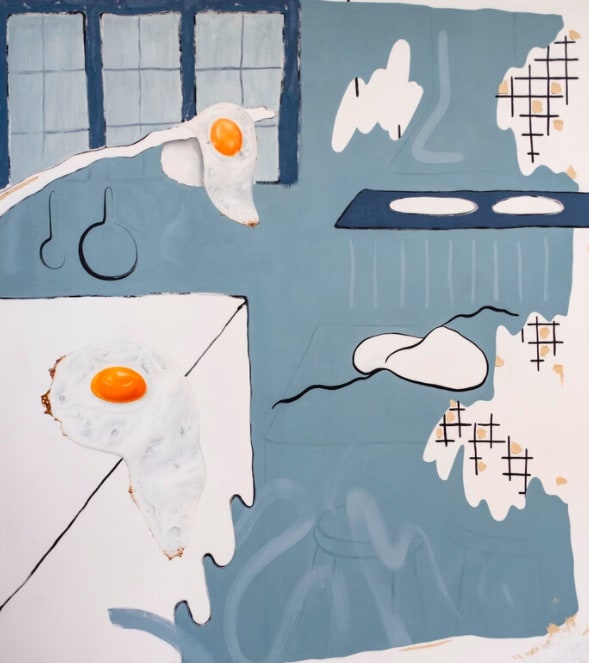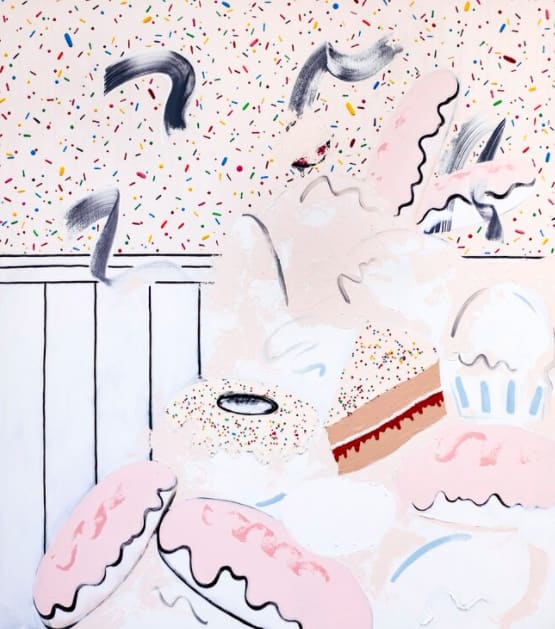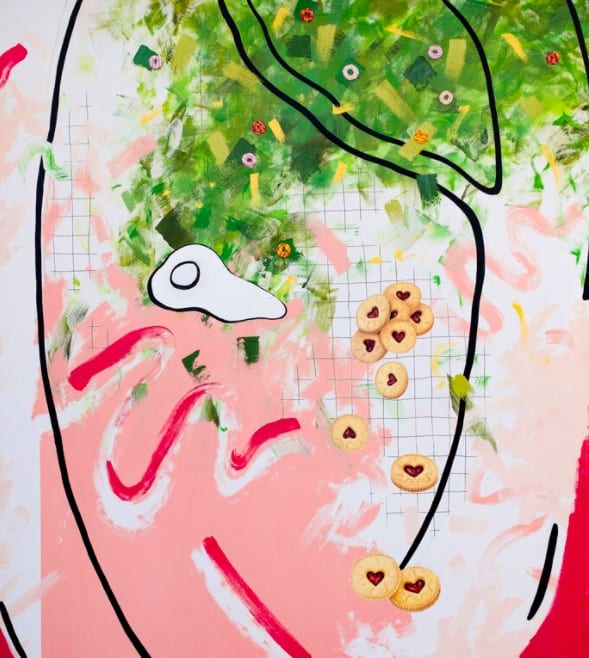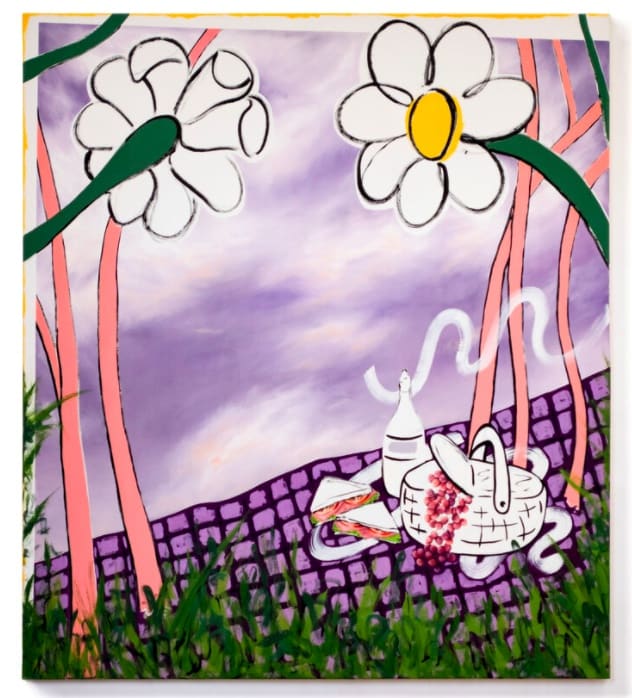EMILIE FITZGERALD
@EMILIE.FITZGERALD.ART
Fitzgerald’s work is something that surprises me daily. The stunning pastel palette like icing, adorning the large scale paintings and canvas.
“Playful, symbolic and nostalgic” is how she would describe her work in three words.
In out interview she shares about her studio (or STUDIOS) arrangement, her narratives, her inspiration drawn from food and we gush over our shared love of Charleston and the Bloomsbury Group @charlestontrust
-
INTERVIEW
EMILIE, This is a tricky one – could you describe your work in 3 words for us?
Playful, symbolic and nostalgic
Perfect! Utterly perfect. Tell us about your artist story… how did you get to where you are now?
I was always quite a creative person but I also was very academic and went to a school where that was far more encouraged than art. I took art up to A Level but decided I wanted a university degree that would result in a career with a stable job (haha!) so I decided to be a mental health nurse and got in to Kings College London. I knew it was the wrong decision for about 6 months before I went to the university but was still firmly in denial (despite bringing all of my art supplies to my uni accommodation). I only lasted three weeks before I just couldn’t stay any longer and pretty much immediately dropped out and went running straight back to my old art teachers. They helped me put together a portfolio and one recommended City & Guilds of London Art School. It was really at the open day there that I think I decided I wanted to be an artist. I think I needed to really know what I didn’t want so that I could see what I absolutely needed and as soon as I went in to that art school it just all felt completely right.

That’s amazing. A woman of many talents and interests. We love it! So where does your inspiration come from for your work?
Ooh food! There are so many things I think about when I look in to what foods I’m depicting. Mostly my references come from children’s stories, nursery rhymes and fairy tales; this is partly because of the nostalgia connected to them but I think there’s also an important aspect of these notions of food being introduced at very young ages. As I researched these stories multiple recurring themes would come up, often around food being the focus of deception and seduction, such as the apple in snow white, and how this often revolves around children or a female protagonist and most time has a negative outcome. I was thinking a lot about how this relates to how we see food now and how its presented to us through advertisement as well as my own relationship to food. I always want my paintings to be open to multiple interpretations, probably more than anything else, so when I think about these themes I don’t necessarily want them to come through in the painting but rather trigger just enough of a memory in the viewer that it makes them think about that story they read or that advert they saw, whether or not it evokes the same feelings is usually down to my depiction of it.
Have you ever had any strange or memorable reactions to your work?
When I was painting these one of my tutors asked if I was painting my favourite foods, after reflecting on it I actually found I didn’t like most of the foods I had been painting! I’m half Irish so I’m going to live up to the stereotypes and say potatoes are my favourite food.
One response that I continued to have and often still do is the reaction to the parts painted realistically, particularly the apples. It was interested watching people walk right up to it and ask if they can touch it (which I’ve always been a huge fan of) and they try to work out if it’s collage or painted. Initially I was resistant to this because I didn’t want it to become a gimmick however as I developed my latest series of paintings I found that my work was becoming more and more about tricks and illusions and I ended up finding ways to heighten the contrast between what is seen as ‘real’ in my painting and what is clearly ‘created’. Another thing I’ve been very aware of is that many people smile when they first see my work and describe how the paintings feel happy and I especially enjoyed watching children running up to the paintings and my ceramic cookies at my degree show. I would be quite proud to be remembered for bringing some happiness and relief to people who see my work.

Aha! Tell me a bit about your studio? Where do you create best?
Absolutely! I have a slightly unusual studio arrangement. My painting studio, or at least most of it, is in Croydon and my ceramic studio is in East Sussex although I’m hoping to soon create a combination of the two when I move to Hastings later this month. The most essential thing in my studio is my studio buddy and other friends and artists that work in the same building, in the months between leaving art school and finding a shared studio space I really began to appreciate how important it is for me to have a studio with people I can bounce ideas off of and get feedback from. This is closely followed by my beanbag which is also definitely essential.
Absolutely – the true essential! What do you hope that your work says to the viewer?
My goal for my paintings is that they say as little as needed to allow the viewer to decide on the rest. I put a lot of symbolic imagery in my paintings but intentionally choose objects or images that can have multiple interpretations. It’s important to me that the paintings evoke some memory or association in the viewer but that I’m not telling them what it is. I’ve been really interested in Donald Winnicott’s idea of a transitional space where something can exist both in reality and in the world of imagination and that’s where I want my paintings to be. There is enough information and enough focus on materiality to make them grounded as being a physical object however the symbolism and nostalgic story telling allows the viewer to impose their own thoughts and experiences on to them.
That’s excellent. I love that. Allowing them to create their own narrative. What are you working on at the moment then?
At the moment I’m working on some ceramics, I’ve been taking the imagery from my paintings and making them in to three dimensional sculptures. The more I make the more they seem to embody my paintings and they’ve become to feel like little characters. I have a large ceramic milkshake that I’ve made and coming out of it is a tongue that’s licking the milkshake spilling over the top and the whole thing is leaning precariously to one side, there’s a sort of comical anthropomorphic element to them.

So, do you have a dream project?
I’ve thought a lot about what my dream project would be! I would love to do a huge installation of sculptures and paintings and create an immersive experience, sort of like those escape rooms where you have to open up parts of paintings or paintings becoming doors to walk through and certain ceramics have hidden things in them to find. I’d love to make something where people can completely engage with the art and be encouraged to come up and touch the paintings and discover things as they go.
Quick ones – who is your favourite historical womEn artists?
Favourite historical female artist… there are so many! I think probably Lee Krasner, I just totally fell in love with her work at the Barbican exhibition. But I do also have a huge appreciation for Helen Frankenthaler and Rose Hilton. I also have been really fascinated lately in Dora Carrington and Vanessa Bell from the Bloomsbury group, although I live right near Charleston house with Vanessa Bell’s beautiful work and the church in Berwick that she painted so maybe that’s why!
Vanessa Bell is one of my favourites! I live near Charleston too! We’ll have to meet there when we can! And your favourite contemporary womxn artist?
My favourite currant female artist would have to be a close tie between Rose Wylie and Laura Owens. I think they both are doing incredible things with paint and treat it in different yet ingenious ways.
I recently on Instagram saw an artist called Pippa Eason who’s work I’ve come to really enjoy. She makes some really incredible forms and they’re sweet and edible and comical but are also slightly uncanny at the same time? Sort of like digital food in video games.


